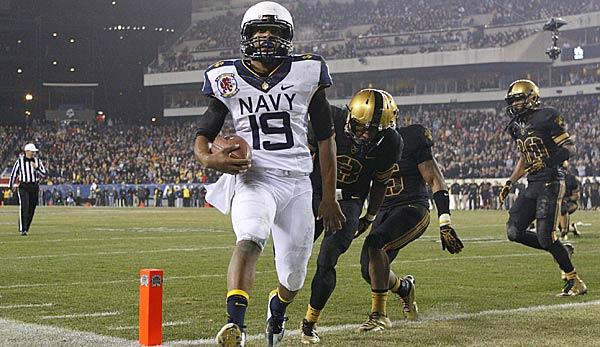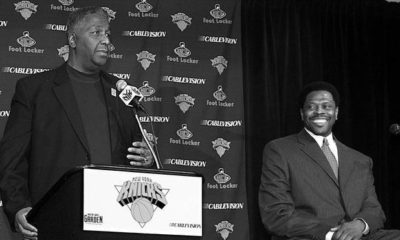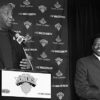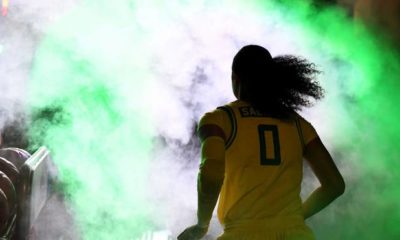US-Sport
Theme Week: Theme Week: Army, Navy and the Triple Option
For some it is a relic of days gone by, for others an argument for the fact that option football can still be extremely dangerous in run games. Either way, the triple option continues to provide insane statistics for a few college football teams and presents defenses with major problems. Day 2 of SPOX College Football Theme Week takes a closer look at the triple option.
Those who followed the NFL last season did not get beyond a certain dose of “option”. This is of course the Run Pass option, which is in a way an extension of the Play Action Pass game.
Unlike Zone Read, which NFL fans met Robert Griffin, Russell Wilson and later Colin Kaepernick in 2012 and which allowed Griffin’s spectacular rookie of the year season, the run pass option also has a dimension in passing. This makes the moves harder to defend on the one hand, on the other hand they can also be implemented with less athletic quarterbacks.
In Zone Read, the quarterback reads a defender – usually a defensive lineman or a linebacker – that has been specifically defined in advance and is usually not blocked, and waits for their reaction in a fraction of a second. Depending on whether the defender points in the direction of the planned course of the running back or whether he attacks the quarterback, the quarterback either pulls the ball back and runs off himself, or passes the ball to the running back.
With the run pass option, the quarterback also reads a specific defender the moment he has to decide whether to pass the ball to the running back or whether to keep it himself. But this can be much more complex and extended, so secondary players are also included in the reads – and instead of running off with the ball himself, he has the opportunity to throw a pass if he keeps the ball. An extension of the play-action pass game, a run is just as possible as a pass.
For college football fans, all these “innovations” in the NFL were of course not an innovation – for many, many teams, the open option in college is the daily bread. And the options often go further. Spread-offenses with wide open, aggressive passing games clearly dominate college football today.
Baker Mayfield in Oklahoma or Mason Rudolph for Oklahoma State are two very recent examples of this. Passing is so clearly the first means of success in modern football that the run game has not only experienced a noticeable loss in value in the NFL – the value of a running back is also increasingly measured by how great its role in passing is.
After the quarterback, all other positions that primarily influence the passing game (cornerbacks, pass rushers, offensive tackles, wide receivers) are of utmost importance for the outcome of a game.
Occasionally there are still teams that rely more intensively on the run game – the Tennessee Titans in recent years, partly also the Dallas Cowboys or currently the Jacksonville Jaguars serve as examples here. But this is still happening to some extent, however much some coaches would like to try: in the NFL you can’t avoid passing.
If you want to travel back in time to the times when the run game dominated football and the passing game was still regarded as exotic (at best) or cowardly (very old school), you have to go to college football. And ideally to the Army, Air Force or Navy.
All three schools play a variant of the modern variant of the triple option, the philosophical baby of Paul Johnson, who also plays it at Georgia Tech. A very run-heavy offense, which really stormed the stage in the 1980s and 90s, and in which option fans get their money’s worth.
To put it directly: Army and Navy care for one of the oldest offenses in college football, which option fans get their money’s worth and lets nostalgics rave about in the past: The triple option Flexbone Open.
The triple option in general was once the dominant offense variant in college. Alabama used it under Bear Brant, Oklahoma played it under Barry Switzer. Titles were won, records set and opponents dominated. Last season, seven more FBS colleges played their version of the Flexbone Triple Option: Navy, Army, Air Force, Georgia Tech, Georgia Southern, New Mexico and Tulane.
This leads to stat lines that make NFL fans doubt their eyes – such as Army’s 64-6 victory over Fordham in 2017, which Army managed without a single pass completion: Ahmad Bradshaw went 0/2 as register, but ran on average for 19.7 yards per run on nine runs. Army stood at the end of the game at 47 runs for 513 yards and eight rushing touchdowns.
Against this background, it comes as no surprise that last year’s Top 5 Rushing Yards per game included four of the teams mentioned above: Army (rank 1/355.8 rushing yards per game), Navy (2/343), Georgia Tech (4/307.4) and Air Force (5/306.9). At the same time, five Flexbone Triple Option teams had the five fewest passes in 2017: Army (61), Navy (101), Georgia Tech (119), Air Force (142) and Georgia Southern (195). Army went through the season with 19 passports in total.
When Paul Johnson discovered the triple option in the late 1980s and began to schematically expand it, he was the 29-year-old offensive coordinator in Hawaii. His quarterback Ken Niumatalolo had never played in an option open at the time, the school had lost several of their top pre-season players.
And yet, Johnson left no room for doubt.
“I quickly saw that this was a special offense. We could move the ball against any defense. I knew that this was not a gimmick openness,” Niumatalolo was later to say, “and it still works. In essence, it’s the same offense. Other things come and go, but option football in itself is intact.”
Sometimes Niumatalolo even becomes really emotional when he talks about the offense: “This offense is proven. People think it’s a gimmick open – but it’s based on numbers, on angles within the plays. Many people do the same things in the spread open, just out of the shotgun. But ultimately it’s about numbers.”
In its basic formation, the Flexbone Offense has three running backs in the backfield: The fullback stands behind the quarterback, which is located under center. On each side of the fullback there is a running back, also called “Slotback” or “Wing Player”. Simply put, there are three options after the snap: The quarterback can pass the ball to the fullback for an inside run, he can run with the ball himself, or he can pitch it to one of the slotbacks.
With the first option, the quarterback usually reads the defensive tackle or defensive end on a predefined page, as with the zone read. If he attacks the quarterback, it’s the handover to the fullback. If the defender hesitates or moves towards the fullback, the quarterback keeps the ball.
If the latter happens, the quarterback keeps the ball and runs. So the first defender has already been taken out of the game via Read, with the ball in his hand the defender will sooner or later come upon another unblocked defender – usually a linebacker or safety.
In the meantime, one of the running backs should be parallel to the quarterback, and so the next read takes place: If the defender concentrates on the quarterback, the pitch is to the side. If the defender hesitates or makes the running back, the quarterback keeps the ball and runs off himself.
Page 1: The triple option Flexbone Offense with absurd statistics
Page 2: Danger for the Defense, Passing – and special conditions for Army and Navy


















You must be logged in to post a comment Login